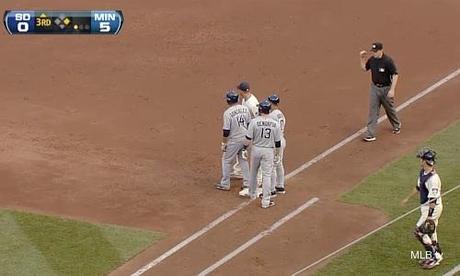The rule.
A) The rule states that two runners cannot occupy the same base and if they do and are both tagged while on the base, the trailing runner is the one called out. Example: A runner on 1st base attempts to go to 3rd on a base hit to left. The lead runner is a dead out at 3rd so he stops and goes back to 2nd base. The batter, however, ran all the way to 2nd base so now they are both at 2nd base. In this case, the batter/runner who went all the way to 2nd base is the trailing runner called out.
B) The second part of the rule states that a runner who is forced to move to the next base, but fails to, would be the runner called out. Example: Runners are on 1st and 2nd base. A ground ball is hit to the 3rd baseman who wants to tag the runner approaching 3rd base. The runner stops and goes back to 2nd base. The trailing runner on 1st base moved to 2nd base on the play so now there are two runners at 2nd base. In this scenario the runner who started the play at 2nd base (the lead runner) would be called out because he was forced to go to third on the play but did not.

Two runners caught at first base. In this case, the lead runner is out due to the force.
What to do on defense.A player who knows the rules as it applies to scenarios A & B will know better how to handle these situations should they arise. Here are some tips for fielders for both scenarios.
A) In this situation, it's important to tag both runners quickly while they are still standing on the bag. This ensures that at least one of them is going to be out. Because, according to the rules, the trailing runner will be out on the play, it's also best to tag this runner first. Here's why. If the lead runner is tagged first, he is not out. When the fielder then goes to tag the trailing runner, the lead runner can leave the bag and possibly run to the next base. If the trailing runner is tagged after the lead runner leaves, the trailing runner is no longer out because he now is the only runner on the base. A very smart lead runner who knows the rules may do this. As a fielder in this situation, it's not a bad idea to stand in front of the lead runner as you tag both of them. This usually prevents the lead runner from leaving the bag. If the fielder tags the trailing runner first and then the lead runner takes off, you now have a chance for a double-play. If both runners are on the bag, tagging the trailing runner first makes him out immediately. Tagging the lead runner after he steps off makes it a double-play.
Another smart thing to do for the fielder is to tag both runners - trailing runner first - and then try to convince the lead runner that he is out. A lead runner that doesn't know the rules might just believe you and step off the bag thinking he's out. When he does, tag him again. Now he is! Double-play!
B) The same tips apply to this play but with the other runner. A fielder should stand in front of the trailing runner, tag the lead runner first, and try to convince the trailing runner that he is out.
These scenarios and the tips that go with them prove that coaches and players should know the rules. A coach should study the rule book and make time in practice to go over common (and uncommon!) situations and how players should respond.
Oh ... and if you are ever one of the runners in these situations, stay on the bag until the umpire points to you and says "you're out."

